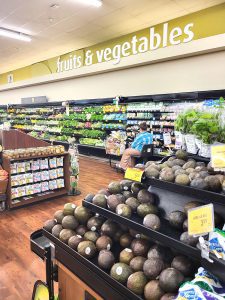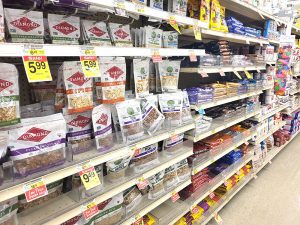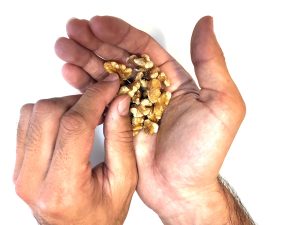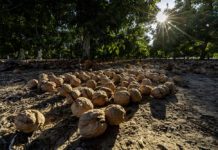
When Robert Verloop took the helm of both the California Walnut Board and the California Walnut Commission on July 11, he brought impressive credentials to an industry that produces the state’s 10th highest-valued crop.
But even this seasoned agricultural executive acknowledges his first months on the dual job will be “baptism by fire” as he immerses himself in the industry’s inner workings and issues. Then he must find and execute solutions that will increase distribution, sales and consumption of California walnuts. And he must do that in an environment of increasing production, global competition, supply chain issues and slumping grower returns.
The hurdles might seem daunting. But Verloop has led California agricultural businesses before.
In 2017, he became chief operating officer for Coastline Family Farms, a Salinas-based vegetable grower-shipper. He served there for five years before accepting the connected positions of the CWB’s executive director and the CWC’s CEO.
Before Coastline, Verloop was executive vice president of marketing and COO of new business development for Naturipe Farms, a grower-owned producer and global marketer of fresh berries. He had already spent seven years with Sunkist Growers, serving as vice president of global marketing and licensing, and nine years with the California Avocado Commission.
Born in The Netherlands, where his family was involved with produce, Verloop moved to California in 1965. He graduated from Cal Poly Pomona with a bachelor’s degree in citrus and avocado production. He then spent three and a half years in Yemen with the U.S. Agency for International Development working in citrus.
After that, he returned to California to work for a Bakersfield-area citrus nursery. From there, he went to Brazil, working for Pandol Brothers in developing counter-seasonal grape production. He came back to the U.S. and worked in avocado and citrus production for a couple more years before moving into marketing and various leadership positions.
Through those industry roles, Verloop gained hands-on experience, both domestically and internationally, in retail and foodservice sales, marketing, branding, packaging and new product development, food safety, strategic business development, issues management, strategic planning and government relations.
That experience will be vital in helping the industry veteran lead the two walnut groups. Two weeks into his new position, an enthusiastic Verloop shared some of his thoughts and plans with West Coast Nut.
Q. How did these two walnut positions come onto your radar?
The Commission and Board wanted to take a fresh look at senior leadership. They wanted someone with a different background to take a zero-based, bottoms-up approach, to look at things with new eyes and implement new ideas and solutions. They contracted with a highly respected executive search agency, and, as a result, I was contacted.
I knew a little about the walnut industry and some of its challenges, many of which are shared throughout California agriculture; the disruption of trade, customer and consumer confidence and economic pressures, weather changes, transportation and logistics bottlenecks and water restrictions. When I learned the two boards of directors desired real, meaningful change and understood the need for new leadership to move the industry forward in what arguably is a maturing competitive global marketplace, I became very interested.
I believe walnuts have been an unspoken hero. There is a huge upside in doing some of the basic block-and-tackling that commodity groups can do to make improvements in California walnuts’ distribution and consumption patterns. Having the opportunity to use my understanding of the challenges and opportunities, to help maximize returns and market penetration, all rolled up into a phenomenal opportunity to serve the California walnut industry.
Q. Among the many industry challenges, which is the biggest?
The biggest challenge the industry faces right now is complacency. If you look at where the walnut industry is today, a lot of things are not significantly different from how business was conducted for many years. Yet the marketplace dynamics have changed dramatically. This lack of internal change may be attributed to many successful years when grower returns were strong and consistent, global markets were expanding, California walnuts set the gold standard, global competition was limited, and growers were planting new acres with new varieties.
Today, the competitive landscape has changed. The new acreage has come into full production, consumer trends have evolved and consumers have more options beyond the nut category. While California walnut growers and handlers are still the preferred source and provider, we have to work harder to ensure our high-quality standards until the moment of consumption. We need to be even more consumer-focused to ensure our customer service and responsiveness are world class.
We need to have the courage to break free from the thinking of the past that got us where we are, to what is required to be successful in the new marketplace.

Q. How do you plan to do that?
Part of that is re-defining what success looks like. We can’t just make a sale or send product out without thinking about what happens to our walnuts before they end up with a consumer. We have to be very thoughtful about the marketplace. I’ve always believed in the saying, “We don’t sell to a retailer, we sell through a retailer.” We inherently have a responsibility to make sure we have the right product at the right place in the right package at the right time at the optimal price.
Q. What will be your biggest push as you get started?
I’m very much looking forward to refocusing the industry through an enhanced and comprehensive strategic planning process that starts from a zero-base approach, so that we’re not repeating things that we’ve done in the past just to do them. I want to make sure it’s inclusive; that all voices can be heard in the planning stage. It needs to coalesce to a point where we have a very strong plan where everybody understands what we’re trying to accomplish, then execute against that on a yearly basis.
Q. What’s the timeframe of your strategic planning intent?
I will propose the complete process to the two boards of directors in the near future. My goal is to work with a cross section of the industry on a strategic-planning task force, starting this fall. The process will determine our ultimate timeline. We need to get this right. We may not be able to address every topic initially. However, my goal is to have a well-vetted program that can serve as a road map for reenergizing and refocusing our industry. I would anticipate having the plan approved by the Board and Commission by spring of next year. That then leads into the annual program planning and budget process, incorporating our committees and always tying back to our strategic plan of overriding goals and objectives.

Q. What are you optimistic about?
We’ve got a vibrant industry that’s going through growing pains right now. We’ve got great people and a good foundation. The building blocks are in place for continued success on many different levels. It’s just hard to talk about that when you look at the amount of carry-in we will have and where grower returns have been over the last few years. We can’t underestimate the impact that COVID-19 has had in changing both consumer behavior and purchase intent, and then also the impact on the business practices of our trading partners like the retailers, wholesalers and distributors. There’s a myriad of issues that, in many ways, are short-term, and we will work through all those.
We need to do a better job telling our story. My goal through the strategic planning process is to look at how we can improve that part of who we are. It’s not just about telling people to buy our products. You have to inspire them. We need consumers and trading partners to better understand what it means to have product coming from California and to create a connection to the people who stand behind our products, I think that’s crucial. It’s a point of differentiation we’ve always been able to drive home and will continue to do.
A Closer Look: The California Walnut Board and the California Walnut Commission
Although they’re separate, the California Walnut Board and the California Walnut Commission share the same executive management and office space in Folsom, Calif. Together, the two organizations represent over 4,500 California walnut growers and nearly 90 handlers. But the two organizations do have different roles.
The CWB represents the state’s walnut growers and handlers. It’s funded by mandatory handler assessments and is governed by a Federal Walnut Marketing Order. The CWB promotes walnut use in the U.S. through advertising, public relations, retail promotions and educational programs. It also provides funding for walnut production, food safety and postharvest research.
The CWC is funded by mandatory grower assessments. It’s an agency of the State of California and works through the California Department of Food and Agriculture. The CWC (www.walnuts.org) mainly focuses on health research and export market development activities.
















